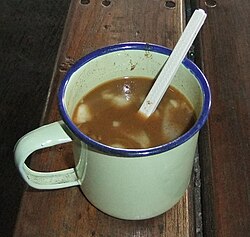
Indonesian cuisine is a collection of various regional culinary traditions that formed in the archipelagic nation of Indonesia. There are a wide variety of recipes and cuisines in part because Indonesia is composed of approximately 6,000 populated islands of the total 17,508 in the world's largest archipelago, with more than 1,300 ethnic groups.
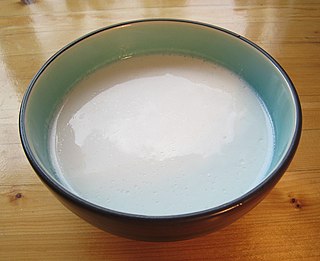
Coconut milk is an opaque, milky-white liquid extracted from the grated pulp of mature coconuts. The opacity and rich taste of coconut milk are due to its high oil content, most of which is saturated fat. Coconut milk is a traditional food ingredient used in Southeast Asia, Oceania, South Asia, and East Africa. It is also used for cooking in the Caribbean, tropical Latin America, and West Africa, where coconuts were introduced during the colonial era.
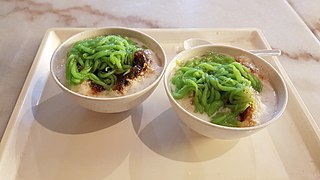
Cendol is an iced sweet dessert that contains droplets of pandan-flavoured green rice flour jelly, coconut milk and palm sugar syrup. It is commonly found in Southeast Asia and is popular in Indonesia, Malaysia, Brunei, Cambodia, East Timor, Laos, Vietnam, Thailand, Singapore, and Myanmar. Next to the green jelly, additional toppings might be added, including diced jackfruit, sweetened red azuki beans, or durian.

Padang dish or Minangkabau dish is the cuisine of the Minangkabau people of West Sumatra, Indonesia. It is among the most popular cuisines in Maritime Southeast Asia. It is known across Indonesia as Masakan Padang after Padang, the capital city of Western Sumatra province. It is served in restaurants mostly owned by perantauan (migrating) Minangkabau people in Indonesian cities. Padang food is ubiquitous in Indonesian cities and is popular in neighboring Malaysia and Singapore.

Serabi, surabi, or srabi is a traditional Balinese–Javanese snack, similar to a pancake, made of a rice flour-based batter with coconut milk or coconut cream and shredded coconut as an emulsifier. Most traditional serabi tastes sweet, as these pancake-like desserts are usually eaten with kinca, a golden-brown coconut sugar syrup in the Sundanese culinary tradition.

Ginger tea is a herbal beverage that is made from ginger root. It has a long history as a traditional herbal medicine in East Asia, South Asia, Southeast Asia, and West Asia.
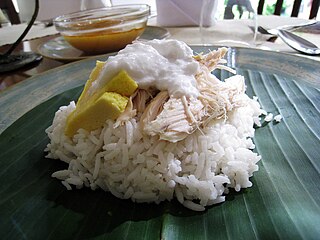
Nasi liwet is an Indonesian dish rice dish cooked in coconut milk, chicken broth and spices, from Solo, Central Java, Indonesia. Common steamed rice is usually cooked in water, but nasi liwet is rice cooked in coconut milk, chicken broth, salam leaves and lemongrass, thus giving the rice a rich, aromatic and succulent taste. Nasi liwet is a traditional Javanese way of cooking rice in coconut milk. There is one variant of liwet rice, the style of Nasi Liwet Sunda from West Java with its unique Sundanese cuisine a different taste and presentation from Sundanese eating tradition called ngeliwet or botram.

Sundanese cuisine is the cuisine of the Sundanese people of Western Java, and Banten, Indonesia. It is one of the most popular foods in Indonesia. Sundanese food is characterised by its freshness; the famous lalab eaten with sambal and also karedok demonstrate the Sundanese fondness for fresh raw vegetables. Unlike the rich and spicy taste, infused with coconut milk and curry of Minangkabau cuisine, the Sundanese cuisine displays the simple and clear taste; ranged from savoury salty, fresh sourness, mild sweetness, to hot and spicy.

Bajigur is a hot and sweet beverage native to the Sundanese people of West Java, Indonesia. The main ingredients are coconut milk and Aren sugar; usually to add taste, a small amount of ginger and a small pinch of salt. Traditionally fragrant pandan leaves were added, but now often artificial vanilla powder is used. It can also include kopi tubruk, finely pounded coffee.

Wajik or wajid, also known as pulut manis, is a traditional glutinous sweet made with rice, sugar and coconut milk. It is an Indonesian kue, and a kuih of Brunei, Singapore and Malaysia.
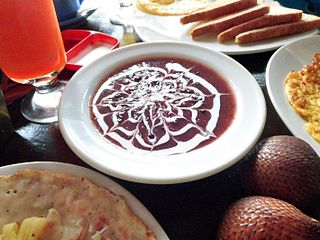
Bubur ketan hitam, bubur pulut hitam or bubur injun is an Indonesian sweet dessert made from black glutinous rice porridge with coconut milk and palm sugar or cane sugar. The black glutinous rice are boiled until soft, and sugar and coconut milk are added. It is often described as "black glutinous rice pudding" and is very similar to black rice tong sui made from black rice. It is often served as dessert or snack, for supper, for tea time, anytime of the day; however, it is a popular choice for breakfast for those who prefer sweet treat instead of its savory counterpart bubur ayam.

Es goyobod is an Sundanese drink from Indonesia. The origin of coconut milk based cold beverage similar to es campur. It is made with shaved ice, coconut milk, sugar syrup, and jellied mung bean starch known as hunkwe. Other ingredients may include avocado and shredded coconut.

Mie koclok, is an Indonesian chicken noodle soup, a specialty of Cirebon city, West Java. The noodles come with a white-colored extra-thick porridge-like soup, made of chicken broth and coconut milk soup, which is coagulated with corn starch or tapioca. Other ingredients include shredded chicken breast, cabbage, bean sprouts, hard boiled egg, kaffir lime juice, and sprinkled with sliced fresh celery, spring onion, and fried shallot.

Empal gepuk or sometimes simply known just as empal or gepuk is an Indonesian sweet and spicy fried beef dish. This dish is commonly popular in Java island, but can trace its origin to Sundanese cuisine of West Java, Indonesia.

Lepet (Javanese), Leupeut (Sundanese), or Lepat (Indonesian) is a type of sticky rice dumpling mixed with peanuts cooked with coconut milk and packed inside a janur or palm leaf. It is a delicacy commonly found in Javanese and Sundanese cuisine, and often consumed as a snack. It is similar to lontong, but with a stickier texture and richer flavor due to the use of coconut milk and peanuts.

Betawi cuisine is rich, diverse and eclectic, in part because the Betawi people that create them were composed from numbers of regional immigrants that came from various places in the Indonesian archipelago, as well as Chinese, Indian, Arab, and European traders, visitors and immigrants that were attracted to the port city of Batavia since centuries ago.

Acehnese cuisine is the cuisine of the Acehnese people of Aceh in Sumatra, Indonesia. This cuisine is popular and widely known in Indonesia. Arab, Persian, and Indian traders influenced food in Aceh although flavours have substantially changed their original forms. The spices combined in Acehnese cuisine are commonly found in Indian and Arab cuisine, such as ginger, pepper, coriander, cumin, cloves, cinnamon, cardamom, and fennel. A variety of Acehnese food is cooked with curry or coconut milk, which is generally combined with meat such as buffalo, beef, goat meat, lamb, mutton, fish, or chicken.

Kue pancong, kue pancung, bandros, gandos, or buroncong is an Indonesian kue or traditional snack made of a rice flour and coconut-based batter and cooked in a special mold pan. It is a commonly found snack in Indonesian traditional markets. Kue pancong is usually associated with Betawi cuisine of Jakarta, while bandros is often associated with Sundanese cuisine of Bandung city, and buroncong with Makassarese cuisine of Makassar, although all refer to the same coconut hot cake.

Indian Indonesian cuisine is characterized by the mixture of Indian cuisine with local Indonesian-style. This cuisine consists of adaptations of authentic dishes from India, as well as original creations inspired by the diverse food culture of Indonesia. Indian influence can be observed in Indonesia as early as the 4th century. Following the spread of Islam to Indonesia and trading, Muslim Indian as well as Arab influences made their way into Indonesian cuisine. Examples include Indian biryani, murtabak, curry and paratha that influenced Acehnese, Minangkabau, Malay, Palembangese, Betawi and Javanese cuisine.
